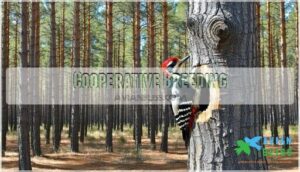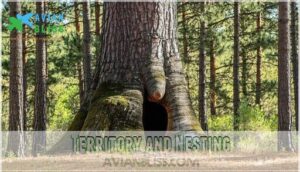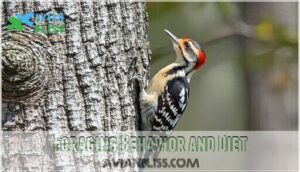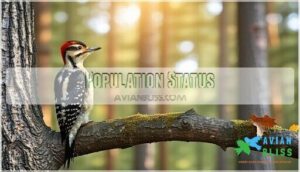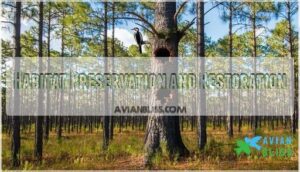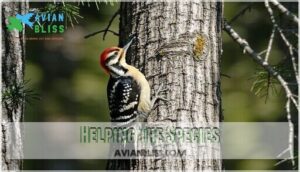This site is supported by our readers. We may earn a commission, at no cost to you, if you purchase through links.

Males display tiny red streaks behind their eyes—their namesake "cockades"—though you’ll need sharp eyes to catch them.
These social birds live in family groups, carving nest holes exclusively in living pine trees softened by red heart fungus.
Once numbering hundreds of thousands, habitat loss nearly wiped them out, leaving fewer than 1,500 groups by the 1970s.
Thanks to aggressive conservation efforts, their population has rebounded to over 7,800 groups today.
Their unique nesting requirements and complex social behaviors reveal fascinating survival strategies.
Table Of Contents
- Key Takeaways
- Red Cockaded Overview
- Habitat and Behavior
- Population Status
- Conservation Efforts
- Helping The Species
- Frequently Asked Questions (FAQs)
- How rare is the red cockaded woodpecker?
- Where do red cockaded woodpecker live in Florida?
- How long do red-cockaded woodpeckers live?
- What do red-cockaded woodpeckers eat?
- How do red-cockaded woodpeckers find food?
- Do red-cockaded woodpeckers migrate seasonally?
- How do red-cockaded woodpeckers avoid predators?
- How long do red cockaded woodpeckers live?
- What predators threaten red cockaded woodpeckers?
- How fast can red cockaded woodpeckers fly?
- Conclusion
Key Takeaways
- You’ll find these crow-sized woodpeckers exclusively in southeastern pine forests, where they’re the only North American woodpecker species that excavates nest cavities in living trees
- You can help save this endangered species by supporting habitat restoration efforts—their population crashed from hundreds of thousands to just 1,500 groups by the 1970s due to habitat loss
- You’ll witness fascinating cooperative breeding behavior where family groups work together, with helper birds assisting parents in raising young and maintaining cavity trees
- You can contribute to their recovery by reporting sightings through citizen science programs and supporting conservation initiatives that’ve already boosted their population to over 7,800 groups
Red Cockaded Overview
You’ll recognize the red-cockaded woodpecker by its distinctive black-and-white barred back and prominent white cheek patches that make it stand out among southeastern pine forests.
This robin-sized bird measures about 9 inches long with a 14-inch wingspan, and males sport a tiny red streak behind the eye that’s often hard to spot in the field.
Physical Characteristics
You’ll immediately notice the Red Cockaded Woodpecker’s distinctive physical characteristics when observing this robin-sized bird.
Their black and white plumage patterns create striking ladder-like designs across their backs, while large white cheek patches contrast sharply with black head markings.
Adult birds measure 20-23 centimeters in length, weigh 40-55 grams, and display a 35-38 centimeter wing span.
Males feature a barely visible red cockade marking behind their eye.
The Red Cockaded Woodpecker’s unique traits are influenced by various bird physical features, which contribute to their overall physical appearance and behavioral characteristics.
Identification and Size
You’ll easily recognize the red cockaded woodpecker by its robin-sized frame and distinctive features.
These woodpecker species measure 7.9-9.1 inches in body length with a 14.2-inch wing span, making bird identification straightforward when you know what to look for.
Key identification features include:
- Head markings – Large white cheek patches contrasting sharply with black caps and moustache stripes
- Beak shape – Straight, chisel-like bill typical of woodpecker facts and anatomy
- Plumage patterns – Ladder-like black and white barring across the back, distinguishing it from other species
These physical characteristics make the red cockaded woodpecker unmistakable in southern pine forests.
Coloration and Unique Markings
You’ll notice the red cockaded woodpecker’s distinctive plumage patterns immediately.
The black crown contrasts sharply with prominent white cheek patches, while subtle facial markings create their signature look.
Males sport a tiny red cockade – a streak barely visible behind the eye.
This coloration helps distinguish them from other woodpecker species, though the red cockaded woodpecker’s markings remain quite understated compared to flashier relatives, with a unique signature look and distinctive features.
Habitat and Behavior
You’ll discover that red-cockaded woodpeckers have some of the most fascinating social behaviors in the bird world, living in tight-knit family groups where helpers assist with raising young.
Their unique nesting habits and specialized foraging techniques make them perfectly adapted to life in southern pine forests, exhibiting fascinating social behaviors.
Cooperative Breeding
You’ll find Red-cockaded woodpeckers living in cooperative breeding groups that include a mated pair plus up to four helpers, usually their previous offspring.
These helper roles involve defending territory, maintaining cavity trees, and feeding nestlings during breeding season.
This cooperative behavior strengthens family dynamics, with males comprising 70-95% of helpers.
These nesting strategies improve reproductive success in challenging pine forest environments.
The use of proper woodpecker nesting materials is essential for their habitat conservation.
Territory and Nesting
You’ll find that red-cockaded woodpeckers establish territories spanning 125 to 200 acres, depending on habitat quality.
These cavity nesters require mature pine forests, where cavity excavation takes one to six years in trees over 80 years old.
Their nesting behavior centers around clusters of cavity trees, with nesting cavities serving multiple family members, reflecting the demanding nature of their breeding patterns and specialized nesting habits.
Foraging Behavior and Diet
Through specialized foraging methods, you’ll find these woodpeckers consuming over 75% arthropods in their diet.
Their bark excavation techniques and insect consumption patterns demonstrate remarkable adaptability in pine forest ecosystems. The woodpeckers’ foraging behavior is influenced by ground feeding behaviors that aid in finding hidden insects.
- Arthropod diet dominance: Ants, beetles, cockroaches, and spiders comprise three-quarters of daily nutrition
- Pine bark foraging expertise: Specialized forked tongues probe beneath bark layers for hidden insects
- Gender-specific territories: Males forage on upper branches while females work lower trunk areas
- Seed eating supplements: Pine seeds, poison ivy berries, and wild fruits provide seasonal variety
- Insect diet specialization: Woodpecker diet focuses on wood-boring larvae and surface-dwelling arthropods
Population Status
You’ll discover that the Red-cockaded Woodpecker’s story represents one of conservation’s most challenging yet inspiring journeys.
This species has faced near-extinction but continues to benefit from dedicated recovery efforts that offer hope for its future survival.
Endangered Status and Threats
The red cockaded woodpecker faces extinction risks as an endangered species since 1970.
Habitat loss has eliminated over 97% of original longleaf pine forests through logging and land conversion.
Population decline continues due to fragmentation effects that isolate remaining groups.
Climate change threatens to reduce suitable habitat by 45% by 2080, while conservation status remains critical with only 6,000 active clusters surviving today.
Historical Distribution and Abundance
The Redcockaded woodpecker’s historic range once spanned 90 million acres across the southeastern United States, stretching from eastern Texas to New Jersey.
This endangered species thrived in extensive longleaf pine ecosystems before European colonization triggered dramatic population trends and geographic distribution changes.
Consider these sobering abundance patterns from our conservation history:
- Early 1900s: Hundreds of thousands of family groups existed
- 1970s: Only 10,000-14,000 clusters remained
- 2000s: Over 97% population reduction occurred
- Present: Just 3% of original habitat survives, showing a significant impact on the species due to European colonization and resulting in a drastic endangered species status.
Restoration Efforts and Successes
Conservation victories prove remarkable for this endangered species.
Habitat restoration programs transformed over 2 million acres into suitable nesting grounds, while artificial cavity installations boosted clusters by 35%.
Translocation efforts moved 600+ birds, achieving 70% population increases across recovery zones.
These wildlife recovery strategies demonstrate how targeted conservation efforts restore ecosystem balance in longleaf pine forests, showcasing the impact of conservation efforts.
Conservation Efforts
You can help protect the red-cockaded woodpecker through targeted conservation efforts that focus on habitat preservation and ecosystem restoration.
These initiatives work to maintain the old-growth pine forests these birds need while reducing the human activities that threaten their survival, which is crucial for the ecosystem restoration.
Habitat Preservation and Restoration
Through careful stewardship, you can witness how habitat preservation and restoration transforms landscapes for this endangered bird.
Reforestation efforts focus on longleaf pine ecosystems, while prescribed burns maintain open understories essential for pine forest habitat. Old-growth continuity supports cavity construction, and strategic pine management creates corridors connecting fragmented populations across restoration sites.
Effective habitat restoration techniques are vital for the conservation of the Red Cockaded Woodpecker.
- Protected lands expanded by 35% since the 1980s, providing stable breeding grounds
- Artificial cavities boost reproduction by 55% where natural sites are limited
- Prescribed fire regimes increase densities by 30% in well-managed pine forests
Reducing Fragmentation and Disturbances
Wildlife corridors linking scattered pine forests help combat habitat fragmentation that threatens red-cockaded woodpeckers.
You’ll find these connective pathways allow genetic exchange between isolated populations, reducing inbreeding risks.
Forest management practices now prioritize creating buffer zones around active cavity trees, while limiting logging activities during breeding season.
Conservation biology research shows that maintaining larger, connected forest blocks supports stable woodpecker communities better than fragmented patches.
Effective forest conservation requires the use of proper forest conservation tools to manage and protect these habitats and support stable woodpecker communities with proper management.
Supporting Ecological Balance
When you protect red-cockaded woodpeckers, you’re supporting a complex web of wildlife interactions that keeps southern pine forests healthy.
These keystone species create cavities used by over thirty-five other animals, from flying squirrels to screech-owls.
Their habitat management practices maintain ecological balance through controlled burns and forest structure that benefits countless species while providing ecosystem services.
The conservation of red-cockaded woodpeckers relies on understanding keystone species roles to inform effective management strategies.
Helping The Species
You can actively support red-cockaded woodpecker recovery through education, community involvement, and citizen science contributions.
Your participation in habitat conservation programs and reporting sightings helps researchers monitor populations and protect this endangered species.
Public Awareness and Education
Raising awareness about red cockaded woodpecker conservation starts with education outreach that makes bird conservation relatable.
When people understand these unique cavity-nesters, they’re more likely to support wildlife conservation efforts.
- Education Outreach: Share fascinating facts about their cooperative breeding and resin wells
- Awareness Campaigns: Promote conservation education through social media and local events
- Environmental Literacy: Teach communities why old-growth pine forests matter for conservation awareness
Community Involvement and Support
You can make a real difference by joining local conservation groups and participating in hands-on Volunteer Work.
Many organizations offer Donation Options and Event Planning opportunities that directly support Red-Cockaded Woodpecker recovery programs.
| Direct Action | Community Impact |
|---|---|
| Habitat restoration workdays | Builds conservation partnerships |
| Fundraising Strategies development | Expands bird conservation programs |
| Social Media awareness campaigns | Strengthens wildlife conservation efforts |
Your community involvement in wildlife conservation initiatives creates lasting change for these endangered woodpeckers.
Reporting Sightings and Contributions
You can report red cockaded woodpecker sightings through citizen science programs like eBird or iNaturalist.
Data submission helps scientists track populations and habitat use. Volunteer opportunities include nest monitoring, habitat restoration, and educational outreach.
Your bird watching contributions directly support species conservation efforts by providing researchers with valuable field data for wildlife protection initiatives.
Conservation efforts rely on understanding local bird conservation methods to protect endangered species. Wildlife protection initiatives are crucial for the survival of these species.
Frequently Asked Questions (FAQs)
How rare is the red cockaded woodpecker?
Looking at this bird’s status, you’ll find it’s critically endangered with only about 15,000 individuals remaining. Once widespread across southeastern pine forests, habitat loss has pushed this species to the brink.
Where do red cockaded woodpecker live in Florida?
You’ll find these woodpeckers in Florida’s slash, longleaf, and loblolly pine forests that’re at least 60-100 years old, scattered across the state’s remaining old-growth pine ecosystems.
How long do red-cockaded woodpeckers live?
You’ll find these woodpeckers typically live about 12-16 years in the wild, though some hardy individuals can reach their early twenties when conditions are just right.
What do red-cockaded woodpeckers eat?
You’ll find these birds feast primarily on arthropods like ants, beetles, cockroaches, and spiders, which make up over 75% of their diet. They also enjoy pine seeds and various fruits.
How do red-cockaded woodpeckers find food?
You’ll spot these skilled foragers flaking away bark scales with their bills, then probing underneath with their specialized forked tongues to extract hidden insects and arthropods lurking beneath.
Do red-cockaded woodpeckers migrate seasonally?
Unlike restless wanderers of the sky, you’ll find these woodpeckers staying put year-round. Red-cockaded woodpeckers don’t migrate seasonally—they’re permanent residents of their southern pine forest territories.
How do red-cockaded woodpeckers avoid predators?
Red-cockaded woodpeckers maintain resin wells around their cavity trees, creating sticky barriers that trap snakes and other predators. You’ll also notice they use cooperative group vigilance for protection.
How long do red cockaded woodpeckers live?
Like a vintage wine aging in your cellar, these woodpeckers can live surprisingly long lives.
You’ll find they typically survive 10-12 years in the wild, though some exceptional individuals reach 15 years or more.
What predators threaten red cockaded woodpeckers?
You’ll find snakes, raccoons, and flying squirrels pose the biggest threats to these woodpeckers.
The birds maintain resin wells around their cavity entrances, creating sticky barriers that deter many would-be predators from climbing up, which helps protect them from predators.
How fast can red cockaded woodpeckers fly?
Ever wondered about these birds’ aerial speed secrets?
You’ll find red-cockaded woodpeckers fly at moderate speeds, typically reaching 15-25 mph during short flights between pine trees.
Though exact measurements remain limited in scientific literature.
Conclusion
Witnessing today’s red cockaded woodpecker population tells a remarkable tale of species recovery.
Through dedicated habitat restoration, careful forest management, and community involvement, you’ve helped transform this bird’s fate from near-extinction to steady growth.
Your continued support for conservation initiatives, reporting sightings, and protecting longleaf pine ecosystems guarantees these distinctive woodpeckers will thrive for generations.
The red cockaded woodpecker proves endangered species can recover when people commit to science-based conservation action.
- https://talltimbers.org/articles/the-legacy-of-the-red-cockaded-woodpeckers-cavities-in-the-forest/
- https://www.srs.fs.usda.gov/pubs/ja/ja_conners014.pdf
- https://www.allaboutbirds.org/guide/Red-cockaded_Woodpecker/overview
- https://www.sciencedirect.com/science/article/pii/S1617138118301584
- https://ecos.fws.gov/docs/recovery_plan/030320_2.pdf

